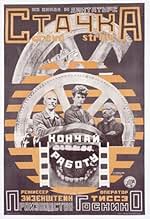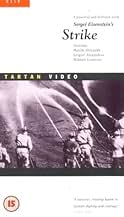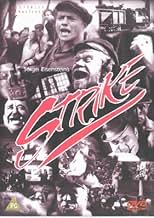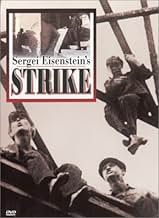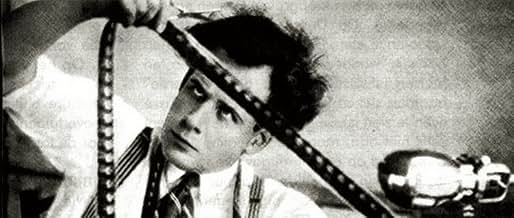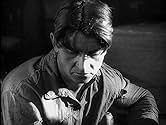IMDb-BEWERTUNG
7,6/10
9123
IHRE BEWERTUNG
Eine Gruppe unterdrückter Fabrikarbeiter tritt im vorrevolutionären Russland in Streik.Eine Gruppe unterdrückter Fabrikarbeiter tritt im vorrevolutionären Russland in Streik.Eine Gruppe unterdrückter Fabrikarbeiter tritt im vorrevolutionären Russland in Streik.
Leonid Alekseev
- Factory Sleuth
- (Nicht genannt)
Daniil Antonovich
- Worker
- (Nicht genannt)
Pyotr Malek
- Police Spy
- (Nicht genannt)
Misha Mamin
- Baby Boy
- (Nicht genannt)
Pavel Poltoratskiy
- Stockholder
- (Nicht genannt)
Empfohlene Bewertungen
Eisenstein's most purely enjoyable film, possibly because the theorems are more lifelike. In many ways a comedy, as the villains (military, police, factory owners, underworld scabs) are caricatured and dehumanised, which makes the eventual horrors all the more shocking. The workers are, of course, idealised, but their paradise of laziness seems odd for a Communist work.
Montage is the thing, as ever with Eisenstein, both in terms of connecting images to create startling insights, and in making tense, exciting and inevitable the action; but there is an astonishing attention to compositional detail too, most haunting perhaps being the empty, abandoned, impotent, machine-heavy factories, or the vast-stepped drawing rooms of the bloated capitalists.
Montage is the thing, as ever with Eisenstein, both in terms of connecting images to create startling insights, and in making tense, exciting and inevitable the action; but there is an astonishing attention to compositional detail too, most haunting perhaps being the empty, abandoned, impotent, machine-heavy factories, or the vast-stepped drawing rooms of the bloated capitalists.
Russian master Sergei Eisenstein's first feature film is a tour-de-force of cinematic technique. He appears to have a pretty speedy learning curve, beginning straight away with a picture that is confidently crafted and extremely watchable even today.
With the exception of Que Viva Mexico (which he made outside Russia), this is Eisenstein's purest film, the one most free from the constraints of the Bolshevik propaganda machine. There is one mention of the Bolsheviks, but it's inconsequential. This is essentially a film about self-organisation of the workers a placeless and timeless story which acts as a case study in how a strike can begin, how it can be made successful and how it can be defeated.
Strike has an incredibly exhilarating pace to it and, aside from its political message works as a pure action film. Perhaps unusually for a debut film, this is also the closest Eisenstein came to making a comedy. In a style that would mark all his films, he characterises the villains of the piece the factory management, police chiefs and government bureaucrats as exaggerated and often ridiculous figures of fun. The factory owner is the stereotypical capitalist a top hat-wearing fat controller.
As usual with early Soviet cinema, Strike is essentially characterless. The story is told through the masses, and the proletariat as a whole is the hero. Eisenstein was ideally suited to this, as even in this early film he gives an unprecedented realism to the crowd scenes, and uses every technique at his disposal to create drama from mass action. Eisenstein also demonstrates early on that he has the rather unusual talent of directing large groups of people being massacred. It's an image that would crop up in nearly all of his films.
The only real weakness of Strike is that it too often slips into pretentiousness. Some of the techniques are little more than showing off. There are just a few too many superimpositions and mirror images shots. The symbolism is also often a little too heavy-handed and abstract the two kids dancing on the table during the interrogation scene certainly baffles me; god knows what the Russian public made of it.
Eisenstein is often described as a pioneer, a founding father of film technique. However, in truth most of the techniques he used had been developed earlier, in particular by D.W. Griffith. It's just that Eisenstein pushed the possibilities of editing to their extreme. He's more of a maverick than a pioneer, as there really has been no-one like him since. Having said that, I can identify three new uses of the editing process that Eisenstein invented with Strike.
Firstly, he often uses a sequence of similar shots to give the impression of the same action being done by lots of people. For example, three shots of tools being thrown to the ground tells us quickly and effectively, in the context of the scene, that the entire workforce is downing tools. Secondly, he edits rhythmically to punctuate action. For example, a quick, dynamic action like someone throwing a punch or a door slamming shut will be punctuated by a film cut, giving it much more impact. This is particularly effective in silent film, as the jarring cuts mean you can almost hear the action in your head.
The third editing technique debuted here was the most abstract and the least influential. Whereas Griffith would edit back and forth between two or more literally related scenes (for example, between someone in trouble and someone coming to rescue them) to build up tension, Eisenstein edits back and forth between unrelated images to create a metaphor. The well-known example of this in Strike is the cutting from the workers being gunned down to shots of cattle being slaughtered the cattle dying is nothing to do with the plot, but it makes a point. It's a clever idea, but one that was rarely imitated as it breaks up the flow of a film's narrative.
On a totally different note, a little hobby of mine is spotting modern day look-alikes in old films, and Strike has one of my favourites. The king of the beggars is a dead ringer for Shane MacGowan, right down to the missing teeth. Amazing.
Strike has to be one of the most remarkable and mould-breaking debut films of all time. It's not quite up to the level of masterpiece yet, but it's an incredible experience and genuinely gripping entertainment.
With the exception of Que Viva Mexico (which he made outside Russia), this is Eisenstein's purest film, the one most free from the constraints of the Bolshevik propaganda machine. There is one mention of the Bolsheviks, but it's inconsequential. This is essentially a film about self-organisation of the workers a placeless and timeless story which acts as a case study in how a strike can begin, how it can be made successful and how it can be defeated.
Strike has an incredibly exhilarating pace to it and, aside from its political message works as a pure action film. Perhaps unusually for a debut film, this is also the closest Eisenstein came to making a comedy. In a style that would mark all his films, he characterises the villains of the piece the factory management, police chiefs and government bureaucrats as exaggerated and often ridiculous figures of fun. The factory owner is the stereotypical capitalist a top hat-wearing fat controller.
As usual with early Soviet cinema, Strike is essentially characterless. The story is told through the masses, and the proletariat as a whole is the hero. Eisenstein was ideally suited to this, as even in this early film he gives an unprecedented realism to the crowd scenes, and uses every technique at his disposal to create drama from mass action. Eisenstein also demonstrates early on that he has the rather unusual talent of directing large groups of people being massacred. It's an image that would crop up in nearly all of his films.
The only real weakness of Strike is that it too often slips into pretentiousness. Some of the techniques are little more than showing off. There are just a few too many superimpositions and mirror images shots. The symbolism is also often a little too heavy-handed and abstract the two kids dancing on the table during the interrogation scene certainly baffles me; god knows what the Russian public made of it.
Eisenstein is often described as a pioneer, a founding father of film technique. However, in truth most of the techniques he used had been developed earlier, in particular by D.W. Griffith. It's just that Eisenstein pushed the possibilities of editing to their extreme. He's more of a maverick than a pioneer, as there really has been no-one like him since. Having said that, I can identify three new uses of the editing process that Eisenstein invented with Strike.
Firstly, he often uses a sequence of similar shots to give the impression of the same action being done by lots of people. For example, three shots of tools being thrown to the ground tells us quickly and effectively, in the context of the scene, that the entire workforce is downing tools. Secondly, he edits rhythmically to punctuate action. For example, a quick, dynamic action like someone throwing a punch or a door slamming shut will be punctuated by a film cut, giving it much more impact. This is particularly effective in silent film, as the jarring cuts mean you can almost hear the action in your head.
The third editing technique debuted here was the most abstract and the least influential. Whereas Griffith would edit back and forth between two or more literally related scenes (for example, between someone in trouble and someone coming to rescue them) to build up tension, Eisenstein edits back and forth between unrelated images to create a metaphor. The well-known example of this in Strike is the cutting from the workers being gunned down to shots of cattle being slaughtered the cattle dying is nothing to do with the plot, but it makes a point. It's a clever idea, but one that was rarely imitated as it breaks up the flow of a film's narrative.
On a totally different note, a little hobby of mine is spotting modern day look-alikes in old films, and Strike has one of my favourites. The king of the beggars is a dead ringer for Shane MacGowan, right down to the missing teeth. Amazing.
Strike has to be one of the most remarkable and mould-breaking debut films of all time. It's not quite up to the level of masterpiece yet, but it's an incredible experience and genuinely gripping entertainment.
This is Eisenstein's directorial debut and alongside Citizen Kane it may be one of the most important debuts in the history of film showcasing a fully-fledged artistic maturity. This is a fictitious narrative-driven movie though it is very consonant with reality. As a Communist Eisenstein's aesthetics was opposed to the "bourgeois" art style that considered the artistic object as a subject of contemplation. Eisenstein advocated in theoretical terms in his books and practically with movies such as this a pragmatic vision of art. Movies should have a purpose; they should mobilize the viewer into action by filing him with emotion.
This strategy is obvious early on with the use of the motto from Lenin that links the idea of organized workers and that of social action in an equation of efficiency. The movie tries to prove that the workers are entitled to organization and that only in such a manner they could achieve their full potential. The movie focuses on the workers as a group; there are no "characters" as we have grown accustomed to seeing on screen. The collective character of the workers, though, has a very powerful emotional impact on the viewer because Eisenstein knows how to present it:
1) The workers are presented in the factory, in what would appear to Chaplin, for instance as a medium of alienation. Here, the workers seem "at home" because they are so many they balance the non-human elements expressed by the machines. More than this the brilliant montage sequences emphasize that the workers are in peace in their environment, the visual patters give a clear feeling of the strength of the united workers. Later on with the advent of sound the beauty of an industrial landscape will be extraordinarily depicted by Vertov in Enthusiasm;
2) The workers are contrasted with the fat and greedy capitalists. Their environment is luxurious and far more "human" than a factory. However, Eisenstein makes it appear as a place of sin and debauchery. The cigar smoke emphasizes the strength of the exploiter much like the smoke from the furnace shows the force of the factory. There are many correspondences between the two environments which Eisenstein later uses to achieve some of the greatest and most emotionally engaging associative montages ever displayed. One of the most impressive shows a boss squeezing a lemon to fix himself a drink while the workers are squished by the police forces trying to repress the strike;
3) Individuals predominantly appear only when they are associated with heavy dramatic scenes, the innocent worker who commits suicide ( who only functions as the dramatic instigator of the plot without any real emotion displayed for the actual character who dies even if we know his actual name; it is insinuated that a human life has a meaning only as part of larger community), the child who is killed by the police, the spies who serve as much needed humorous debouches that relieve the tension associated with the workers exploitation but that also build up tension in the sense that they show the stupidity of the bosses and of their methods;
4) The key to the movie is its pragmatics. It is after all a propaganda piece and the ending clearly shows it. The advice addressed to the proletarians not to forget is charged with emotion because it discharges a tension that has been carefully build frame by frame at a rampant pace. Even if we disengage with his doctrine we should keep in mind that Eisenstein's genius can only be acknowledged in its cultural context and related to his conception of art's function in a society. We can screen out the propaganda but we must keep the emotion in order to understand this movie today at its full power.
This strategy is obvious early on with the use of the motto from Lenin that links the idea of organized workers and that of social action in an equation of efficiency. The movie tries to prove that the workers are entitled to organization and that only in such a manner they could achieve their full potential. The movie focuses on the workers as a group; there are no "characters" as we have grown accustomed to seeing on screen. The collective character of the workers, though, has a very powerful emotional impact on the viewer because Eisenstein knows how to present it:
1) The workers are presented in the factory, in what would appear to Chaplin, for instance as a medium of alienation. Here, the workers seem "at home" because they are so many they balance the non-human elements expressed by the machines. More than this the brilliant montage sequences emphasize that the workers are in peace in their environment, the visual patters give a clear feeling of the strength of the united workers. Later on with the advent of sound the beauty of an industrial landscape will be extraordinarily depicted by Vertov in Enthusiasm;
2) The workers are contrasted with the fat and greedy capitalists. Their environment is luxurious and far more "human" than a factory. However, Eisenstein makes it appear as a place of sin and debauchery. The cigar smoke emphasizes the strength of the exploiter much like the smoke from the furnace shows the force of the factory. There are many correspondences between the two environments which Eisenstein later uses to achieve some of the greatest and most emotionally engaging associative montages ever displayed. One of the most impressive shows a boss squeezing a lemon to fix himself a drink while the workers are squished by the police forces trying to repress the strike;
3) Individuals predominantly appear only when they are associated with heavy dramatic scenes, the innocent worker who commits suicide ( who only functions as the dramatic instigator of the plot without any real emotion displayed for the actual character who dies even if we know his actual name; it is insinuated that a human life has a meaning only as part of larger community), the child who is killed by the police, the spies who serve as much needed humorous debouches that relieve the tension associated with the workers exploitation but that also build up tension in the sense that they show the stupidity of the bosses and of their methods;
4) The key to the movie is its pragmatics. It is after all a propaganda piece and the ending clearly shows it. The advice addressed to the proletarians not to forget is charged with emotion because it discharges a tension that has been carefully build frame by frame at a rampant pace. Even if we disengage with his doctrine we should keep in mind that Eisenstein's genius can only be acknowledged in its cultural context and related to his conception of art's function in a society. We can screen out the propaganda but we must keep the emotion in order to understand this movie today at its full power.
Sergei Eisenstein's "Strike", like his more well-known films, is interesting and contains some memorable imagery. The story is worthwhile in itself, and it repays careful attention because of the considerable detail that is shown using Eisenstein's distinctive approach. It lacks any particularly interesting characters, but then, so did "Battleship Potemkin". Only an occasional lack of polish sets this apart from Eisenstein's later films.
The story starts with the situations that provoke the strike, and then follows developments on both sides of the dispute. It becomes surprisingly involved for what seems at first to be a simple confrontation. There is quite an assortment of situations, settings, and characters. On occasion, the images are overdone, occasionally even off-putting, but you can already see the creative use of imagery that Eisenstein would later use so effectively.
"Strike" will probably be of interest mainly to those who already appreciate Eisenstein's films, but it is worth seeing. It is really only a cut below "Potemkin", which itself, though generally the most-praised of his films, might actually be surpassed by some of his later works. In any case, "Strike" displays the same kind of style, and has several of the characteristics of the fine classics that were to come.
The story starts with the situations that provoke the strike, and then follows developments on both sides of the dispute. It becomes surprisingly involved for what seems at first to be a simple confrontation. There is quite an assortment of situations, settings, and characters. On occasion, the images are overdone, occasionally even off-putting, but you can already see the creative use of imagery that Eisenstein would later use so effectively.
"Strike" will probably be of interest mainly to those who already appreciate Eisenstein's films, but it is worth seeing. It is really only a cut below "Potemkin", which itself, though generally the most-praised of his films, might actually be surpassed by some of his later works. In any case, "Strike" displays the same kind of style, and has several of the characteristics of the fine classics that were to come.
In the Soviet Union in 1903, the workers of a factory are tired of poor wages, hard living, and harsh treatment by their superiors. Talk of a strike is rife, and when one innocent worker is accused of theft, he hangs himself on the production line and unwittingly becomes a martyr. The strike is decided, and the workers gather in masses to discuss their terms. Meanwhile, the fat cats upstairs are in uproar that the strike has been called, and employ a number of secret agents with animal code names to infiltrate, brutalise and spy on the strikers. As the workers begin to fight amongst themselves, the bosses tactics become increasingly brutal, especially when the police are called in.
Sergei Eisenstein is one of the Soviet Union's greatest ever filmmakers, and arguably one the world's greatest. This was his first feature-length film (he made The Battleship Potemkin later that year, one of the best and most influential films ever made) and his trickery and style is awe- inspiring, given his inexperience and the fact that cinema was still in its early stages. The most effective technique Eisenstein plays is in the early scenes, where he juxtaposes different animals with the key players (Eisenstein was known as the 'King of Montage'). For example, there is an owl, always watching, thinking and cunning, turning into a wild-eye spy; a fox, misleadingly beautiful and sly, becoming a shapeshifting and handsome con-artist - and dancing bears, that portray the workers. The use of this is at its most powerful at the end, when the police move in to overthrow the strike, cut with scenes of a cow having its throat cut, blood gushing out of its wound as it slowly dies.
It's an incredibly stylish piece for its day and moves along at an alarming pace, even when compared to some films today. It never slows down to develop any characters, instead using its revolutionary and Communist themes to play the main role, with the characters being mere pawns in a more important overlying theme. It's clear where Eisenstein's stance is, which does also work against the film. The factory bigwigs are no more than faceless fat men in expensive suits, drinking champagne and smoking cigars all day, laughing at the misfortune of the workers. There is also a scene where one wipes his shoes clean with the workers wage demands. By today's standards, it seems a bit stereotypical, and the metaphors quite obvious. But this is an alarmingly stylish debut from a truly great film-maker, that is both exciting, and come the end, really quite shocking.
www.the-wrath-of-blog.blogspot.com
Sergei Eisenstein is one of the Soviet Union's greatest ever filmmakers, and arguably one the world's greatest. This was his first feature-length film (he made The Battleship Potemkin later that year, one of the best and most influential films ever made) and his trickery and style is awe- inspiring, given his inexperience and the fact that cinema was still in its early stages. The most effective technique Eisenstein plays is in the early scenes, where he juxtaposes different animals with the key players (Eisenstein was known as the 'King of Montage'). For example, there is an owl, always watching, thinking and cunning, turning into a wild-eye spy; a fox, misleadingly beautiful and sly, becoming a shapeshifting and handsome con-artist - and dancing bears, that portray the workers. The use of this is at its most powerful at the end, when the police move in to overthrow the strike, cut with scenes of a cow having its throat cut, blood gushing out of its wound as it slowly dies.
It's an incredibly stylish piece for its day and moves along at an alarming pace, even when compared to some films today. It never slows down to develop any characters, instead using its revolutionary and Communist themes to play the main role, with the characters being mere pawns in a more important overlying theme. It's clear where Eisenstein's stance is, which does also work against the film. The factory bigwigs are no more than faceless fat men in expensive suits, drinking champagne and smoking cigars all day, laughing at the misfortune of the workers. There is also a scene where one wipes his shoes clean with the workers wage demands. By today's standards, it seems a bit stereotypical, and the metaphors quite obvious. But this is an alarmingly stylish debut from a truly great film-maker, that is both exciting, and come the end, really quite shocking.
www.the-wrath-of-blog.blogspot.com
Wusstest du schon
- WissenswertesStrike (Russian: Streik (1925)) is a Soviet silent propaganda film edited and directed by Sergei Eisenstein. Originating as one entry out of a proposed seven-part series titled "Towards Dictatorship of the Proletariat," Strike was a joint collaboration between the Proletcult Theatre and the film studio Goskino. As Eisenstein's first full-length feature film, it marked his transition from theatre to cinema, and his next film Panzerkreuzer Potemkin (1925) (Russian: Bronenosets Potyomkin) emerged from the same film cycle.
- PatzerThe story is set in 1903. Throughout the film, automobiles from the 1920s appear on streets. One is the 1920s auto that the worker (who stole the administrators' posted reply to workers' demands) tried to use to escape police goons during a nighttime rainstorm. When upper-class women appear, they are wearing contemporary 1920s fashions, and the popular music that's on the sound track is also from the 1920s.
- Zitate
Title Card: At the factory, all is calm. BUT. The boys are restless.
- Alternative VersionenThe film was restored at Gorky Film Studio in 1969.
- VerbindungenEdited into Ten Days That Shook the World (1967)
Top-Auswahl
Melde dich zum Bewerten an und greife auf die Watchlist für personalisierte Empfehlungen zu.
- How long is Strike?Powered by Alexa
Details
- Laufzeit1 Stunde 22 Minuten
- Farbe
- Sound-Mix
- Seitenverhältnis
- 1.33 : 1
Zu dieser Seite beitragen
Bearbeitung vorschlagen oder fehlenden Inhalt hinzufügen



